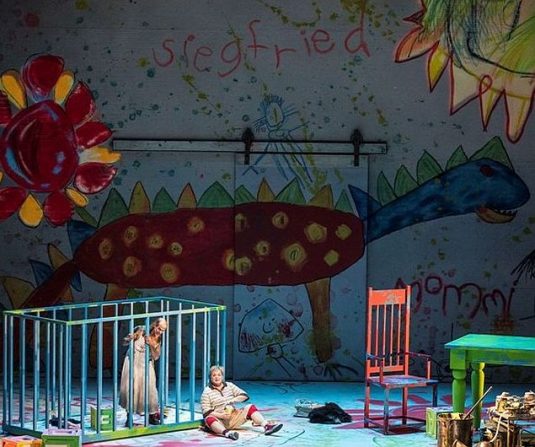
3.5 stars
Opera goers who saw “Das Rheingold” in 2016 and “Die Walküre” in 2017, Lyric’s first two operas segments of Wagner’s four-part “Der Ring des Nibelungen,” will find the next segment, “Siegfried,” still has tall scenery towers bookending the stage. They deliberately remind audiences that Wagner’s The Ring cycle is theater.
It is theatrical and musical drama. But where the productions of the first two segments were highly creative but serious, “Siegfried” is playful, fanciful, serious fun.
The tone is set when a somewhat menacingly large, three-nail-claw and an eye of Fafner, the giant-turned dragon who guards the ring, appear under the curtain and draw audience laughter. The curtain then rises to reveal Siegfried’s playroom of oversized art work and children’s furniture including a tall playpen.
Audiences quickly learn that Siegfried is a child-like, young adult of immature willfulness. However, the glorious voice of German tenor Buurkhard Fritz, portraying Siegfried in his Lyric debut, is anything but immature.
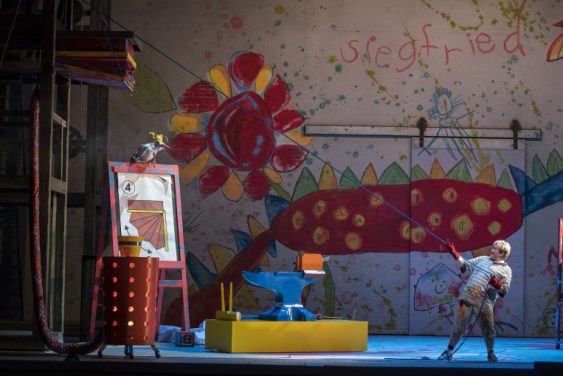
Unfortunately, Lyric’s fine orchestra under the baton of the legendary Andrew Davis, sometimes drowns him out when Wagner’s dramatic music crescendos such as in the famed “Forging Song” at the end of Act I. Siegfried sings it as he pulls on the bellows while recreating the broken sword of his father that he will need to slay the dragon.
Keeping to the plaything motif, costumed theater hands bring in and uncover boxes that contain all that Siegfried needs to forge the sword.
Meanwhile, Mime, a malicious dwarf portrayed with wonderful flair by German tenor Matthias Klink in his Lyric debut, sings as he brews a poison potion to serve Siegried after the boy, basically a man-child, kills Fafner to get the ring.
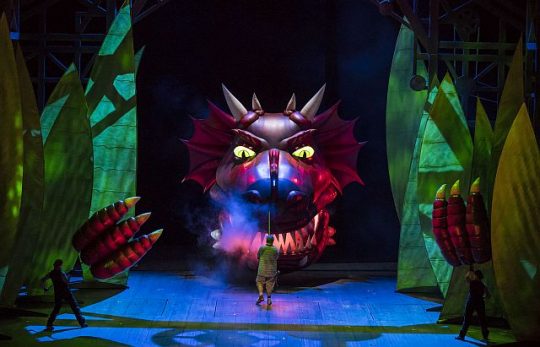
The first act’s 85 minutes pass quickly but its contents are very important to the whole opera. They remind the audience of the mythological gods, other beings and their interaction in the first two parts of the cycle.
Begun in 1951, “Siegfried” actually came first, was worked on in 1956 and Siegfried’s death became Gotterdammerung, the fourth and last part of The Ring cycle. The first two segments, written later, were the prequel for when the entire opera was completed in 1871. It premiered at the Bayreuth Festival in 1876.
The prequel information is cleverly disguised in Act I when the chief god Wotan, calling himself The Wanderer, enters Mime’s hut. He tells Mime that in exchange for a short visit he will forfeit his head if he can’t answer the dwarf’s three questions and the reverse will be true when he puts forth three questions.
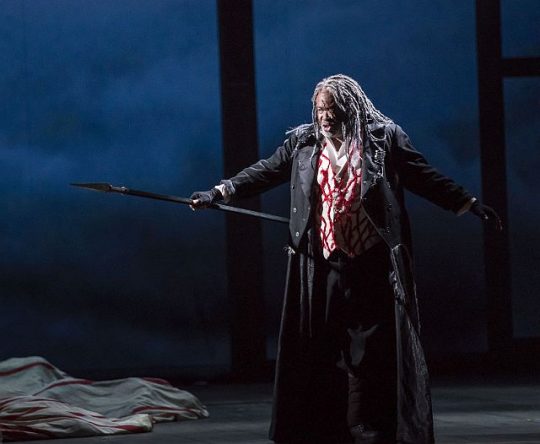
Mime’s three questions are about who lives in the bowls of the earth, on earth and in the heavens. The answers are key to the first two segments.
Wotan, a fearful-looking, black-caped presence on stilts, is commandingly sung by American bass baritone Eric Owens who continues the role he had in “Das Rheingold” and “Die Walküre.”
After Mime answers the first two questions correctly The Wanderer asks Mime who will slay the dragon. Mime doesn’t know that the answer is “he who does not experience fear” but he doesn’t die by Wotan’s hand.
Of course it is Siegfried, Wotan’s grandson as the offspring of Siegmund and Sieglinde introduced in “Die Walküre” who killsFafner, sung by American bass and Lyric regular Patric Guetti in Act II. Siegfried goes on to rescue Brünnhilde from a rock where her father, Wotan, had sent her in “Die Walküre.” Siegfried finds her and learns about love in Act III.
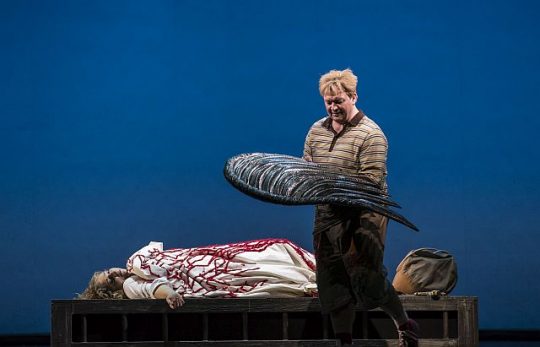
During his Act II adventures, Siegfried encounters a forest bird, American soprano (“Trouble in Tahiti”) Diana Newman. The bird tells him to take the ring and Tarnhelm, the magic helmet, from Fafner’s cave and also tells him about Brünnhilde.
As with Owens, American soprano Christine Goerke superbly continues the vocally demanding role of Brünnhilde that she sung in “Die Walküre.”
Mime’s brother, Alberich from “Das Rheingold,” sung again by South Korean bass-baritone Samuel Youn, is back to reclaim the ring he once possessed.
American mezzo-soprano Ronnita Miller is Erda, the earth goddess consulted by Woten at the beginning of Act III.
Directed by David Pountney and surrounded by the storybook-style scenery conceived by the original designer, the late Johan Engels, and further developed by Robert Innes Hopkins, the drama’s three acts are strewed with fanciful touches and the characters are everything hoped for when a mythological tale comes to life.
Opera goers should not let the total time of five hours stop them from seeing “Siegfried.” Averaging out to about 80 minutes per act, audiences get four hours of glorious singing and Wagner’s wondrous music. Two intermissions of 30 minutes each between the acts add the fifth hour.
DETAILS: “Siegfried” by Richard Wagner is at the Lyric Opera of Chicago, 20 N. Wacker Drive, Chicago, thru November 16. Running time is five hours with two intermissions. For tickets and other information call (312) 827-5600 or visit Lyric Opera.
Jodie Jacobs
For more shows visit Theatre in Chicago
